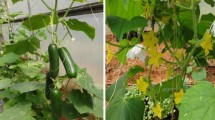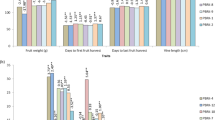Abstract
This study was conducted to develop inbred backcross lines (IBLs) in Indian slicing cucumber (Cucumis sativus L.) with the gynoecious trait. The F2 mapping population was developed using the Indian monoecious cultivar of light-green-fruited Pusa Uday as the recurrent parent and the American gynoecious pickling line G421 as a donor. Two markers, SSR13251 and SSR15516, were found to be closely linked to the F locus at 1.5 and 4.5 cM, respectively, by marker analysis of F2 individuals. The amplified product of 430 bp generated using a SCAR marker (CsACS1G) in gynoecious (MMFF) and sub-gynoecious (MMFf) plants of the F2 population confirmed the dominance of F alleles. The IBLs were developed by backcrossing Pusa Uday with BC1 and BC2 progenies followed by foreground and background selection of plants displaying the gynoecious habit in the background of Indian slicing cucumber. These IBLs could be utilized for the development of hybrids with higher yield, earliness, and quality.



Similar content being viewed by others
Data availability
The data generated during the current study is available from corresponding author on reasonable request not publicly available.
References
Behera TK, Staub JE, Behera S, Delannay IY, Chen JF (2011) Marker-assisted backcross selection in an interspecific Cucumis population broadens the genetic base of cucumber (Cucumis sativus L.). Euphytica 178:261–272
Delannay IY, Staub JE (2011) Molecular markers assist in the development of diverse inbred backcross lines in European Long cucumber (Cucumis sativus L.). Euphytica 178:229–245
Dijkhuizen A, Kennard WC, Havey MJ, Staub JE (1996) RFLP variation and genetic relationships in cultivated cucumber. Euphytica 90:79–87
Fazio G, Staub JE, Stevens MR (2003) Genetic mapping and QTL analysis of horticultural traits in cucumber (Cucumis sativus L.) using recombinant inbred lines. Theor Appl Genet 107:864–874
Horejsi T, Staub JE (1999) Genetic variation in cucumber (Cucumis sativus L.) as assessed by random amplified polymorphic DNA1. Genet Resour Crop Evol 46:337–350
Huang SW, Li RQ, Zhang ZH, Li L, Gu XF, Fan W, Lucas WJ, Wang X, Bingyan X, Ni P et al (2009) The genome of the cucumber, Cucumis sativus L. Nat Genet 41:1275–1281
Jat GS, Munshi AD, Behera TK, Choudhary H, Dash P, Ravindran A, Kumari S (2018) Genetics and molecular mapping of gynoecious (F) locus in cucumber (Cucumis sativus L.). J Hort Sci Biotech 94:24–32
Knopf RR, Trebitsh T (2006) The Female-Specific CsACS1G gene of cucumber. A case of gene duplication and recombination between the non-sex-specific 1-aminocyclopropane-1-carboxylate synthase gene and a branched-chain amino acid transaminase gene. Plant Cell Physiol 47:1217–1228
Lander ES, Green P, Abrahamson J, Barlow A, Daly MJ, Lincoln SE (1987) MAPMAKER: an interactive computer package for constructing primary genetic linkage maps of experimental and natural populations. Genomics 1:174–181
Li J, Zhiwei Q, Xiuyan Z (2011) Genetic analysis of gynoecious in cucumber (Cucumis sativus L.) Institute of Agricultural Information, Chinese Academy of Agricultural Sciences. Retrieved from http://www.caas.net.cn (in Chinese with English Abstract)
Lou FQ, Chen FJ, Chen ZL, Wolukau NJ (2007) Identification of an AFLP marker linked to a locus controlling gynoecy in cucumber and its conversion into SCAR marker useful for plant breeding. Acta Horticult 763:75–82
Lu HW, Miao H, Tian GL, Wehner TC, Gu XF, Zhang SP (2015) Molecular mapping and candidate gene analysis for yellow fruit flesh in cucumber. Mol Breed 35:64
Meglic V, Staub JE (1996) Inheritance and linkage relationships of allozyme and morphological loci in cucumber (Cucumis sativus L.). Theor Appl Genet 92:865–872
Meglic V, Serquen F, Staub JE (1996) Genetic diversity in cucumber (Cucumis sativus L.): I. A re-evaluation of the U.S. germplasm collection. Genet Resour Crop Evol 43:533–546
Miao H, Zhang SP, Wang XW, Zhang ZH, Li M, Mu SQ, Cheng ZC, Zhang RW, Huang SW, Xie B, Fang Z, Zhang Z, Weng Y, Gu X (2011a) A linkage map of cultivated cucumber (Cucumis sativus L.) with 248 microsatellite marker loci and seven genes for horticulturally important traits. Euphytica 182:167–17
Miao M, Yang X, Han X, Wang K (2011b) Sugar signaling is involved in the sex expression response of monoecious cucumber to low temperature. J Exp Bot 62:797–804
Mibus H, Tatlioglu T (2004) Molecular characterization and isolation of the F/f gene for femaleness in cucumber (Cucumis sativus L.). Theor Appl Genet 109:1669–1676
More TA, Munger HA (1987) Effect of temperature and photoperiod on gynoecious sex expression and stability in cucumber. Veg Sci 14:42–50
More TA, Seshadri VS (1998) Development of tropical gynoecious lines in cucumber. Cucurbit Genet Cooperative Rep 11:17–18
Murray MG, Thompson WF (1980) Rapid isolation of high molecular weight plant DNA. Nucleic Acids Res 8:4321–4326
Nitsch J, Kurtz EB, Livermann JL, Went FW (1952) The development of sex expression in cucurbit flowers. Am J Bot 39:32–43
Pandey S, Ansari WA, Pandey M, Singh B (2018) Genetic diversity of cucumber estimated by morpho-physiological and EST-SSR markers. Physiol Mol Biol Plants. https://doi.org/10.1007/s12298-017-0489-9
Park Y, Sensoy S, Wye C, Antonise R, Peleman J, Havey MJ (2000) A genetic map of cucumber composed of RAPDs, RFLPs, AFLPs, and loci conditioning resistance to papaya ring spot and zucchini yellow mosaic viruses. Genome 43:1003–1010
Pati K, Munshi AD, Behera TK (2015) Inheritance of gynoecism in cucumber (Cucumis sativus L.) using genotype GBS-1 as gynoecious parent. Genetika 47:349–356
Perl-Treves R (1999) Male to female conversion along the cucumber shoot: approaches to studying sex genes and floral development in Cucumis sativus. In: Ainsworth CC (ed) Sex determination in plants. BIOS Scientific Publishers, Oxford, pp 189–215
Perl-Treves R, Rajagopalan PA (2006) Close, yet separate: patterns of male and female floral development in monecious species. In: Ainsworth C (ed) Flower development and manipulation. Blackwell, Oxford, pp 117–146
Pierce LK, Wehner TC (1990) Review of genes and linkage groups in cucumber. HortSci 25:605–615
Ren Y, Zhang ZH, Liu JH, Staub JE, Han YH, Cheng Z, Li X, Lu J, Miao H, Kang H, Xie B, Gu X, Wang X, Du Y, Jin W, Huang S (2009) An integrated genetic and cytogenetic map of the cucumber genome. PLoS One 4:e5795
Serquen FC, Bacher J, Staub JE (1997) Mapping and QTL analysis of a narrow cross in cucumber (Cucumis sativus L.) using random amplified polymorphic DNA markers. Mol Breed 3:257–268
Shaw NL, Cantliffe DJ, Rodriguez JC, Taylor S, Spencer DM (2000) Beit Alpha cucumber: an exciting new greenhouse crop. Proc Fla State Hortic Soc 113:247–253
Shengjun Z, Peng Z, Yuquing Z, Xinjuan C, Liping C (2013) Identification of SSR markers linked to gynoecious loci in cucumber (Cucumis sativus L). J Zhejiang Univ (Agric Life Sci) 39:291–298 (in Chinese with English Abstract)
Shiber A, Gaur RK, Rimon-Knopf R, Zelcer A, Trebitsh T (2008) The origin and mode of function of the Female locus in cucumber. In: Pitrat M (ed) Proceedings of the IXth EUCARPIA meeting on genetics and breeding of Cucurbitaceae. INRA, Avignon
Staub JE, Serquen FC, McCreight JD (1997) Genetic diversity in cucumber (Cucumis sativus L.): III. An evaluation of Indian germplasm. Genet Res Crop Evol 44:315–326
Staub JE, Serquen FC, Horejsi T, Chen JF (1999) Genetic diversity in cucumber (Cucumis sativus L.): IV. An evaluation of Chinese germplasm. Genet Res Crop Evol 46:297–310
Staub JE, Chung SM, Fazio G (2005) Conformity and genetic relatedness estimation in crop species having a narrow genetic base: the case of cucumber (Cucumis sativus L.). Plant Breed 124:44–53
Staub JE, Delannay IY, Chen JF (2011) USDA, ARS Cucumis hystrix-derived U.S. processing cucumber inbred backcross line population. HortSci 46:1428–1430
Tanksley SD, Ganal MW, Martin GB (1995) Chromosome landing: a paradigm for map-based gene cloning in plants with large genomes. Trends Genet 11:63–68
Tanurdzic M, Banks JA (2004) Sex-determining mechanisms in land plants. Plant Cell 16:61–71
Trebitsh T, Staub JE, O’Neill SD (1997) Identification of a 1-aminocyclopropane-1-carboxylic acid synthase gene linked to the Female (F) locus that enhances female sex expression in cucumber. Plant Physiol 113:987–995
Weng Y, Sun ZY (2012) Major cucurbits (chapter1). In: Wang YH, Behera TK, Kole C (eds) Genetics, genomics and breeding of cucurbits. CRC Press, New York, pp 1–16
Weng YQ, Johnson S, Staub JE, Huang SW (2010) An extended microsatellite genetic map of cucumber (Cucumis sativus L). HortSci 45:880–886
Wenzel G, Kennard WC, Havey MJ (1995) Quantitative trait analysis of fruit quality in cucumber: QTL detection, confirmation, and comparison with mating-design variation. Theor Appl Genet 91:53–61
Win KT, Zhang C, Song K, Lee JH, Lee S (2015) Development and characterization of a co-dominant molecular marker via sequence analysis of a genomic region containing the Female (F) locus in cucumber (Cucumis sativus L.). Mol Breed 35:229
Yamasaki S, Fujii N, Matsuura S, Mizusawa H, Takahashi H (2001) The M locus and ethylene-controlled sex determination in andromonoecious cucumber plants. Plant Cell Physiol 42:608–619
Yang L, Li D, Li Y, Gu X, Huang S, Mas JG, Weng Y (2013) A 1681-locus consensus genetic map of cultivated cucumber including 67 NB-LRR resistance gene homolog and ten gene loci. BMC Plant Biol 53:1–14
Zhang WW, He H, Yuan G, Du H, Yuan LH, Li Z, Yao D, Pan J, Cai R (2009) Identification and mapping of molecular markers linked to the tuberculate fruit gene in the cucumber (Cucumis sativus L.). Theor Appl Genet 120:645–654
Zhang SP, Miao H, Gu XF, Yang YH, Xie BY, Wang XW, Huang S, Du YC, Sun RF, Wehner TC (2010) Genetic mapping of the scab resistance gene in cucumber. J Am Soc Hortic Sci 135:53–58
Zhang SP, Liu MM, Miao H, Zhang SQ, Yang YH, Xie BY, Wehner TC, Gu XF (2013) Chromosomal mapping and QTL analysis of resistance to downy mildew in Cucumis sativus. Plant Dis 97:245–251
Zhang S, Liu S, Miao H, Wang M, Liu P, Wehner TC, Gu X (2016) Molecular mapping and candidate gene analysis for numerous spines on the fruit of cucumber. J Hered 107:471–477
Zhu WY, Huang L, Chen L, Yang JT, Wu JN, Qu ML, Yao DQ, Guo CL, Lian HL, He HL, Pan JS, Cai R (2016) A high-density genetic linkage map for Cucumber (Cucumis sativus L.): Based on specific length amplified fragment (SLAF) sequencing and QTL analysis of fruit traits in Cucumber. Front Plant Sci 7:437
Acknowledgements
The authors would like to acknowledge the Department of Biotechnology (DBT), Govt. of India, Ministry of Science and Technology for the financial support (project code BT/PR6489/AGII/106/880/2012) and CRP on Molecular Breeding, Indian Council of Agricultural Research (ICAR) (project code 12-143-H-TG-3121) to conduct research activities on Marker Assisted Breeding. The authors declare no conflict of interest.
Author information
Authors and Affiliations
Contributions
TKB conceived the experiments, writer, and analyst of results. TKB, ADM and HC supervised the project. GB, GSJ, AR, SK and RK collected data, provided technical support and management of crop. All authors reviewed and approved this submission.
Corresponding author
Ethics declarations
Conflict of interest
There is no conflicts of interest associated with this publication, and as corresponding author, I assure that all authors of this paper have fulfilled these authorship criteria and mentioned contribution of each author in text.
Additional information
Communicated by Younghoon Park.
Publisher's Note
Springer Nature remains neutral with regard to jurisdictional claims in published maps and institutional affiliations.
Rights and permissions
About this article
Cite this article
Behera, T.K., Boopalakrishnan, G., Jat, G.S. et al. Deriving stable tropical gynoecious inbred lines of slicing cucumber from American pickling cucumber using MABB. Hortic. Environ. Biotechnol. 63, 263–274 (2022). https://doi.org/10.1007/s13580-021-00392-5
Received:
Revised:
Accepted:
Published:
Issue Date:
DOI: https://doi.org/10.1007/s13580-021-00392-5




